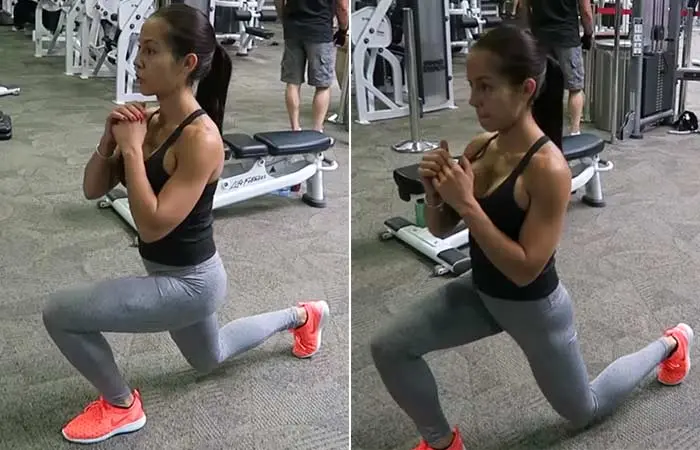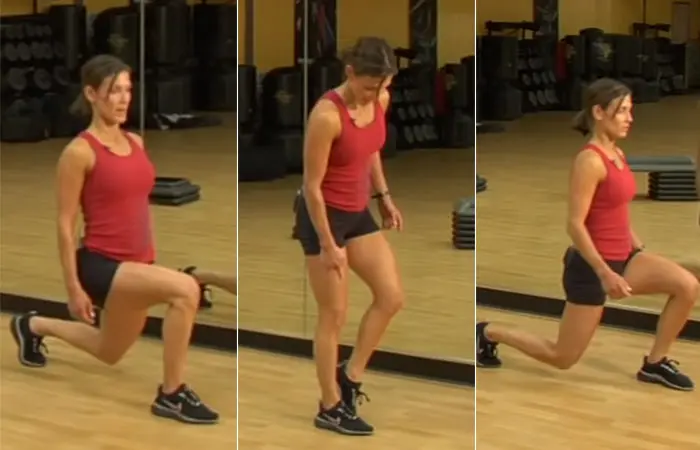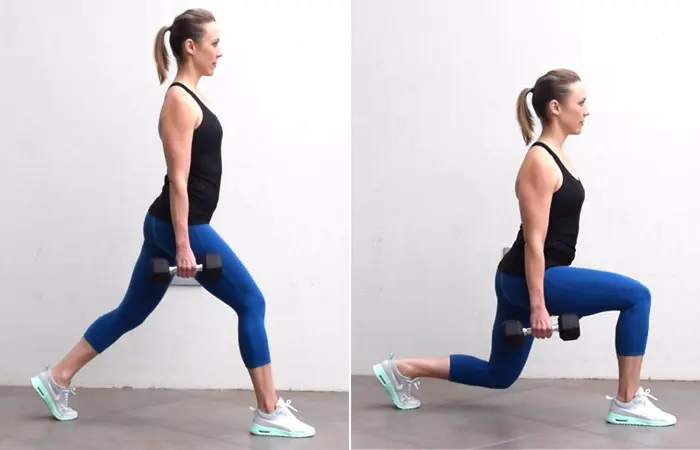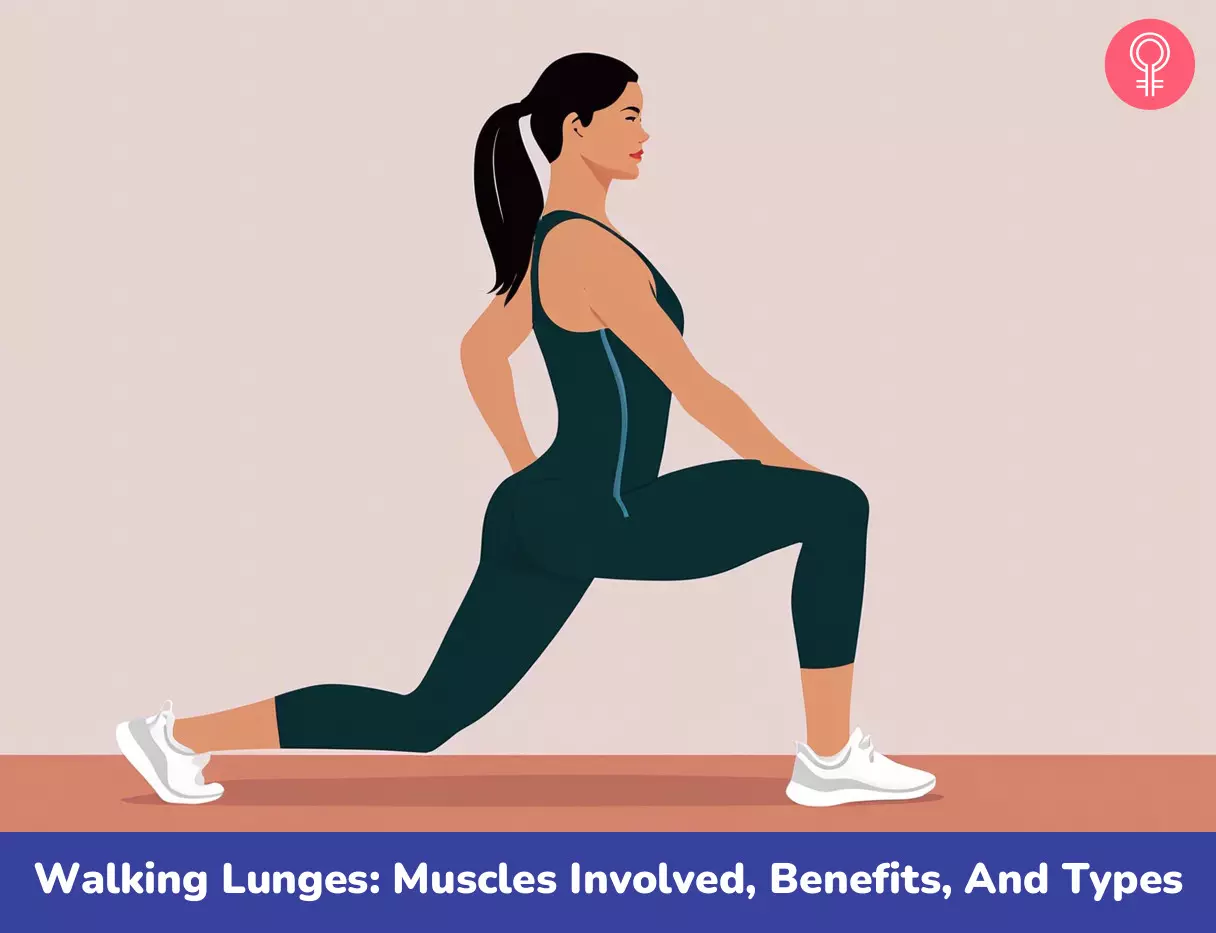According to the survey reports by National Center for Health Statistics, 46.9% of adults met the recommended aerobic physical activity as per the Physical Activity Guidelines. 24.2% of adults met both aerobic and muscle-strengthening activity. This exercise helps tone thigh muscles, boosts strength and flexibility, improves hip and core stability, enhances balance, and leads to improved athletic performance. Read on to know the benefits of walking lunges, how to do them, and the muscles this exercise targets.
Types Of Lunges
Stationary Lunges
The stationary lunge includes a downward movement that involves a strong eccentric contraction of the hams, quads, and glutes. It is one of the most effective quad-strengthening exercises that ensures the entire weight of the body falls on the forward leg. The leg that trails (the backward leg) provides balance and support to the body. During the upward movement, both the legs take the pressure to push the body back to the standing position.
Walking Lunges
In the walking lunge, the downward movement remains the same, with the same pressure being put on all the leg and thigh muscles. However, the upward movement is different. All the focus is on the forward leg. All the muscles of the forward leg are contracted maximally in the attempt to stand straight again. One needs stability while performing this exercise.
Walking Lunges With Weight
In this, all the movements are the same as that in walking lunges. You need to hold a dumbbell in each hand while doing this exercise.
What Muscles Do Walking Lunges Work?
Muscles worked in lunges involve the core, butt, and legs. Walking lunges work on the following muscles and muscles groups:
Gluteal muscles Hamstring Quadriceps Calves Core muscles Back muscles
In the following section, we have given you a step-by-step guide to perform walking lunges. Take a look.
How To Do Walking Lunges
Benefits Of Walking Lunges
Walking lunges benefits include:
1. Improve Balance
A workout based on lunges works both sides of the body, making it a unilateral exercise, which is best for improved coordination and balance (1). Exercises like squats and dead-lifts cannot provide similar results.
2. Boost Functionality
Walking lunges train the body in such a way that its functionality improves many folds. They also help one acquire a better body posture (2).
3. Aid Symmetrical Toning
Since walking lunges concentrate on the ignored parts of the body, they can help you achieve a symmetrically toned body. Walking lunges workouts take care of body parts that other exercises tend to overlook. A study on soccer players showed that practicing forward lunges helped to strengthen hamstring muscles and improved the running speed (3).
4. Boost Hip Flexibility
Walking lunges boost the flexibility of the hip flexor muscles, which tend to become tight due to the sedentary lifestyle we lead (4). Apart from stretching exercises, lunges are a remarkable way to impart flexibility to the hip and thigh muscles (1).
5. Tone The Gluteal Muscles
The gluteal muscles are mostly left unutilized during regular workouts. Walking lunges can help focus on glute activation and also mobilize them with regular practice (2).
6. Improve Core Stability
Standing unilateral exercises (all forms of lunges) help to strengthen the core and improve stamina (5). They help to strengthen the core muscles with their up and down motion.
7. Provide Rest For The Spine
While most forms of exercise would leave your back strained, walking lunges tend to provide rest and recovery to your spine. If you are into heavy workouts and weight training, walking lunges can be the perfect way to rest your spine (6). Note: Walking lunge is one of the best exercises for sportspersons. It improves leg endurance, overall lower limb strength, and the firing pattern of the glutes and the hams.
Precautions
As walking lunges require more balance and coordination, there are chances of you falling. To reduce risk of injury, concentrate on your breathing and practice walking lunges under proper supervision. Keep your spine and upper body erect while performing walking lunges. Do not lean forward. Engage your core and balance your torso and hip while doing this total body workout.
Does walking lunges improve my fitness? Yes, you may do walking lunges to improve your fitness. Calum Alexander Fraser, a physiotherapist, says, “Walking lunges are a great exercise to help improve your fitness as they are a complex multi-joint movement that can be used to improve both your strength and your endurance.” How can I make walking lunges more challenging? You can make them as challenging as you would like. Fraser suggests, “Try holding onto a kettlebell while lunging to make your legs work harder or hold a water bag above your head for an all-over core stability workout.” Are walking lunges good for weight loss? Yes, walking lunges can help you lose weight. According to Fraser, lunges can be turned into a heavy-strength workout by carrying heavier weights. He says, “It can be a more challenging workout by using unstable weights and a cardio workout by doing them for an extended period of time.” He also adds, “For maximum weight loss benefits a combination of heavy-weighted lunges and high-intensity lunges with less recovery is recommended.” Can you do walking lunges every day? Yes, you can do walking lunges every day under proper supervision. However, perform different combinations of exercises for improved body composition and better results. How many sets of walking lunges should I do? You can do 10-20 repetitions with 2-3 cycles. If you are a beginner, start slowly and increase the pace gradually. Do walking lunges make your thighs bigger? Walking lunges help tone up thigh muscles. If you want bigger thighs, combine lunges with other forms of exercise and lift weights. It is one of the best exercises for toned thighs. How long does it take to see results from lunges? Lunges, when performed the right way and consistently, can show you visible results in 2 to 6 weeks. Why do walking lunges hurt so much? In comparison to lunges, walking lunges are more physically demanding and challenging. Their advanced difficulty also makes an individual susceptible to poor posture while performing the exercise, which further causes pain. Should my knee touch the ground during walking lunges? No, your knee should not touch the ground while performing walking lunges. Maintain good form and balance and keep your knee aligned with your ankles while you perform this exercise (1).
Illustration: Walking Lunges: Muscles Involved Benefits And Types













